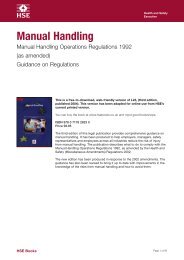Making Companies Safe - what works? (CCA ... - Unite the Union
Making Companies Safe - what works? (CCA ... - Unite the Union
Making Companies Safe - what works? (CCA ... - Unite the Union
Create successful ePaper yourself
Turn your PDF publications into a flip-book with our unique Google optimized e-Paper software.
law. For example, a study in <strong>the</strong> UK by <strong>the</strong> Eagle Star insurance group revealed that only 30<br />
per cent of <strong>the</strong> firms surveyed fully complied with health and safety legislation. 3 Also, any<br />
consideration of current levels of preventable death, injury and ill health in <strong>the</strong> UK clearly<br />
indicate a need for fur<strong>the</strong>r action.<br />
However, HSE’s approach to securing improvements should be based on <strong>what</strong> <strong>the</strong> empirical<br />
evidence suggests is most likely to work. And <strong>the</strong> evidence suggests that, first and foremost,<br />
considerable achievements could be secured by significantly increasing current levels of HSE<br />
inspection and enforcement. There is also strong evidence to suggest that <strong>the</strong> imposition of<br />
personal liability on key senior decision-makers would greatly increase senior management<br />
commitment to, and action on OHS. Finally, <strong>the</strong>re is strong evidence that introducing<br />
regulations to extend and streng<strong>the</strong>n employees’ right to consultation and participation, and<br />
<strong>the</strong> creation of enforcement tools for worker safety representatives, would have a large and<br />
measurable impact on rates of occupational injury and ill health.<br />
These, <strong>the</strong>refore, should be <strong>the</strong> priority areas for HSC/E attention, effort and resources. This<br />
also implies that new strategies – such as <strong>the</strong> development of partnerships – may prove<br />
to be valuable complementary interventions, but that <strong>the</strong>y should add to, and not replace,<br />
core inspection, investigation and enforcement activity by regulators. In short, if any of<br />
<strong>the</strong>se alternative levers are to have a positive effect, <strong>the</strong>y can only do so within <strong>the</strong> framework<br />
of a well-resourced, politically supported and thus credible, deterrence-based enforcement<br />
strategy.<br />
1 Health and <strong>Safe</strong>ty Commission (2004: 14).<br />
2 Horbury et al. (2002).<br />
3 Discussed in O’Dea and Flin (2003: 8).<br />
106
















